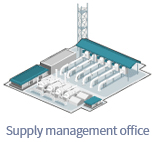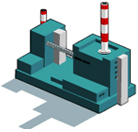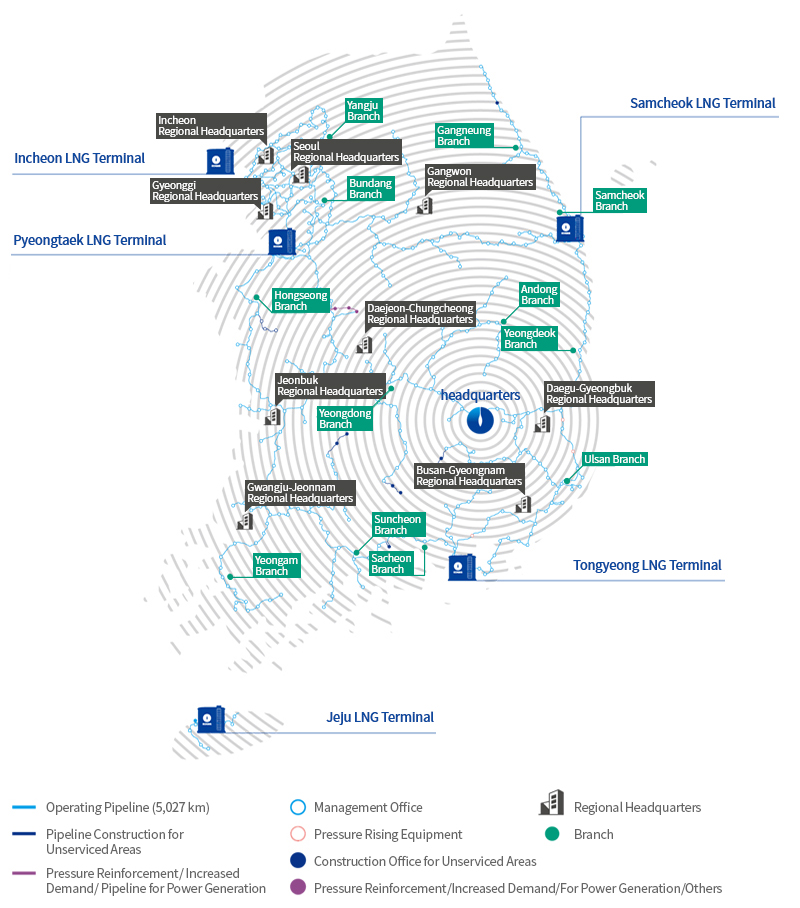KOGAS
KOGAS Pipeline Network

The KOGAS pipeline network extends from the natural gas production bases in Incheon, Pyeongtaek, Tongyeong, and Samcheok, to the boundary lines of city gas companies or power plants in each region, with a total length of 5,140 km.
In general, pipes with a diameter of 20 to 30 inches are used, and the pressure of the gas passing through the pipe is between 8.5 and 70 kg/cm2, which is the force that can push water up to a height of 85 to 700 m vertically. In addition, KOGAS is supplying natural gas safely and stably by constructing a looped pipe network, so that it can be supplied in the reverse direction in case of emergency such as supply interruption.Supply Management Office

Here at the supply management office, the high pressure at which natural gas is sent from the production base through underground pipeline is reduced to the pressure required for city gas companies or power plants, and the amount of supplied gas is measured. In the event of an emergency, supply is cut off, and the gas is discharged into the atmosphere through a diffusion tower.
The supply management office houses a valve to cut off supply, a gas heater that increases the temperature of the gas to meet the customers’ supply conditions and to prevent equipment damage due to temperature drop when pressure is lowered, a gas meter to measures the amount of gas supplied to the customer, and a diffusion tower that dissipates gas to prevent accidents. The functions of each supply management office differ depending on their importance as follows.-
Governor Station
In order to lower the pressure of natural gas being transported through the national gas pipeline network to the pressure required by city gas companies and power plants, a governor station is installed at each supply and demand point. This is in charge of metering, as well as blocking and dissipation functions in case of emergency.
-
Valve Station
In case of emergencies such as accidents while supplying city gas, the valve station blocks and dissipates gas promptly to prevent the exacerbation of accidents.
-
Block Valve
In case of emergencies such as accidents while supplying city gas, this simple management office quickly cuts off the gas supply to prevent the exacerbation of accidents.
-
Operational Monitoring and Control
In KOGAS, where our primary management goal is to supply natural gas safely, the supply management office can monitor status and control supply on-site, but in case of emergency, remote monitoring and control can be performed from 9 regional control centers scattered around the country, and from a central control center located at the headquarters.
City Gas Companies

“City gas” refers to fuel gas that is industrially manufactured in a city, and sold to many consumers through supply pipes. Natural gas, naphtha, and liquefied petroleum gas (LPG) are used as main fuels, but natural gas is the main fuel in Korea.
In Korea’s natural gas business, wholesale and retail businesses are separated, so KOGAS carries out import and wholesale business, and city gas companies (private for-profit corporations) exclusively supply (retail) natural gas supplied by KOGAS to end users (general consumers) in each jurisdiction for residential, heating, and business purposes.Power Plants

Natural gas is supplied as a direct energy source to general households and industries (for city gas), and as an indirect energy source to power plants for power generation.
- Eligibility : Limited to plants that use natural gas for power generation, and have a capacity of at least 100 MW
- Use : For LNG combined cycle power generation, and self-consumption power generation
- Supply pressure : 23?33 kg/cm2 (However, Pyeongtaek’s pressure is 8.5 kg/cm2 + 10%)




